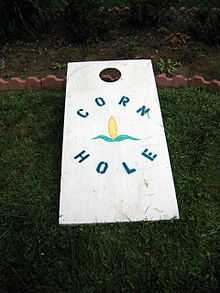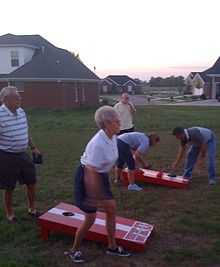Cornhole

Cornhole, also known as Tailgate, bean bag toss, doghouse, or simply Bags, is a lawn game in which players take turns throwing bags of corn at a raised platform with a hole in the far end. A bag in the hole scores 3 points, while one on the platform scores 1 point. Play continues until a team or player reaches the score of 21.
Rules
Equipment and court layout
Cornhole matches are played with two sets of bags and two platforms.[1]
There are four bags to a set. Each set should be identifiable from the other; different colors work well. Bags should be filled with one pound (US) of corn and measure 6" by 6".[1] The final weight of the bag may vary due to the material of the bag itself.
Each platform is 2 ft x 4 ft, with a 6-inch hole centered 9 inches from the top. Each platform should be angled with the top edge of the playing surface 12 inches above the ground, and the bottom edge 3-4 inches above the ground. A regular court places the holes 33 ft apart, or 27 ft between the bottoms of the platforms. Shorter distances can be used when younger players are participating or there is not sufficient room.[1]
Bags are tossed from the pitcher’s box which is the rectangular area directly to the left or right of a platform. The bottom of the platform forms the foul line. Players may not step over the foul line while pitching.[1]
Gameplay
Cornhole matches are broken down into innings or frames [1] of play. During each frame, every player throws four bags. A player may deliver the bag from either the left or right pitcher's box, but, in any one inning, all bags must be delivered from the same pitcher's box. It is possible that both players can throw from the same pitcher's box. Also, the player gets a three foot box to throw in. Each player must deliver the bag within twenty seconds. The time starts when the player steps onto the pitcher's box with the intention of pitching. The player who scored in the preceding inning pitches first in the next inning. If neither pitcher scores, the contestant or team who pitched last in the preceding inning pitches first in the next inning. Note: No foot can land past the front of the board until the corn bag leaves the hand, otherwise the point does not count. At the end of the round there is a 10 second window to allow beans to fall within the bag, possibly allowing additional points.
Cornhole can be played as either doubles or singles. In doubles play, four players split into two teams. One member from each team pitches from one cornhole platform and the other members pitch from the other. The first side of players alternate pitching bags until both players have thrown all four of their bags, then the players pitching from the opposing cornhole board continue to alternate in the same manner until all four of their bags are delivered and the inning or frame is completed. In singles play, two players play against each other. Delivery is handled in the same manner as doubles play. Both contestants pitch from the same cornhole platform and alternate their pitches until all of their bags have been pitched, completing the inning or frame.[2]
Scoring

In order to score, the bags must either be tossed into the hole or land on the board. A bag that falls through the hole is worth a value of three points. The bag can be tossed directly into the hole, slide into the hole, or be knocked into the hole by another bag. A bag that lands on the board and is still on the board at the end of the inning is worth one point. If a bag touches the ground and comes to rest on the board, it is removed from the board prior to continuation of play and not worth any points. Usually, cancellation scoring is used. In one version of cancellation scoring, bags that fall in the hole and bags that land on the board that are pitched by opponents during an inning cancel each other out. For example, if one team lands two bags in the hole and one on the board for seven points, and the other team lands one in the hole and two on the board for five points, the first team's score would be three, and the second team's score would be one. This is because both teams had at least one bag land in the hole, cancelling three points, and one bag on the board, cancelling one point, for a total of four points cancelled from each team. Another example would be if one team gets one in the hole and the other team gets three on the board, no points would be cancelled and both teams would receive three points.[3] In case of a tie, the team who ties the game, must go first.[2]
In another common version of cancellation scoring, the total score for each team for the inning is totalled each round, and then the difference of the two scores is awarded to the team with the higher score. It is thus only possible for one team to score points each inning. For example, if one team lands two bags in the hole and one on the board for 7 points, and the other team lands one bag in the hole and two on the board for 5 points, 5 points from the round would cancel out, and the first team would thus score 2 points. Because only one team can score points in each inning, it is impossible for teams to reach or exceed 21 points in the same inning, and therefore ties are impossible. Although, while playing with this method, players who have already reached 21 points can, in any way, discard their bag so they do not exceed their 21 points.
A cornhole match is played until the first player or team reaches or exceeds twenty-one points at the completion of an inning. The winning team does not need to win by two or more points.[2]
An uncommon version of scoring also includes a 2-point option. A bag is worth 2 points if it is on the board and hanging over the hole, but has not fallen through the hole.
Other scoring variations require one team to earn exactly twenty-one points to win. If a team's score exceeds 21 after any inning, the result differs among various house rules. Options include that the team must return to fifteen points, that the team must return to their prior score, that the team must return to their prior score and deduct one point from that score, and that the team must return to their prior score and deduct from that the number of points they scored in the most recent inning. In some variations, if a team's score goes over 21 three times before their opponents reach or exceed 21, they win the match.
History
The history of the game is mostly unknown,[4] though stories abound. One story claims that the game was first played during the 14th century in Germany, then rediscovered in Virginia, and in the tundras of Alaska, within the last century.[4] Many American scholars confirm that a game of very similar nature was played amongst Native Americans in Midwest America, who filled pigs' bladders with dried beans and competitively tossed them for entertainment, notably, the Blackhawk tribe in Illinois.
Terminology
The following is a list of terms commonly used in cornhole:
- Ace or cow pie: A bag lands on the board, which is worth one point.[5][6]
- Altamira: A bag that goes "nothing but hole" even though there is a "blocker" and "backstop" (in reference to entering a cave of the same name)
- Back door or Dirty Rollup: A cornhole that goes over the top of a blocker and into the hole.[5][6]
- Backstop: A bag that lands past the cornhole but remains on the board creating a backboard for a slider to knock into without going off the board.[5]
- Blocker: An ace that lands in front of the hole, essentially blocking the hole from sliders.[5][6]
- Cornado: When a player dominates a game in such a way that they destroy everyone in their wake.
- Cornament: A cornhole tournament
- Cornfusion: When players or teams cannot agree on the scoring of a given inning.[5]
- Cornhole or Drāno: A bag that falls in the hole, which is worth three points.[5] The alternative name is a reference to a trademark, that of a sink clog clearing product.
- Cornstar: A person who defines supreme confidence, nearly divine ability, and a frequent disregard for authority. [7]
- Dirty bag: A bag that is on the ground or is hanging off the board touching the ground.[6]
- Grasshopper: A bag that bounces off the grass or ground and lands on the board for a point.[6]
- Screaming Eagle: A bag that goes beyond the board without hitting the board.[5][6]
- Gusher, Jumanji, double deuce, Cornholio, Catorce Four Bagger or Four Pack: Four cornholes by a single player in a single round.[5]
- Hammer: The last bag tossed each round. (Curling uses the same term for the last stone thrown in an end.)
- Hanger or Shook: An ace on the lip of the hole ready to drop.[5][6]
- Honors: The team who tosses first, resulting from the team scoring last.[6]
- Hooker: A bag hitting the board and hooking or curving around a blocker and going in the hole.[5]
- Jumper: A bag that strikes another bag on the board causing it to jump up into the cornhole.[5]
- Leprechaun: When a player attains all four bags onto the board without getting any into the hole.[5]
- Nothing But Hole: An expression that means the bag passed through the cornhole without touching the rim.
- Police: The cornhole referee.[5]
- Romanyk: When a player sinks all four bags in a row. "Menage a Manyk" Is when the Romanyk is completed back to back
- Sally: A toss that is thrown too weakly and lands on the ground before reaching the board.[5]
- Shucker: When a player pitches a bag and it strikes an opposing players bag knocking it off the board.[5]
- Skunk, whitewash or shutout: A game that, by some rules, ends in an 11–0 score.[5][6]
- Slider: A cornhole that slides into the hole.[5][6]
- Swish: A bag that goes directly in the hole without touching the board.[6]
See also
- Horseshoes
- Muckers
- Ladder Toss
- Washer pitching
- Lawn game
- Mölkky
References
| Look up cornhole in Wiktionary, the free dictionary. |
- ↑ 1.0 1.1 1.2 1.3 1.4 "American Cornhole Organization Official Cornhole Rules".
- ↑ 2.0 2.1 2.2 "ACA Official Rules of Cornhole". Retrieved 2008-09-13.
- ↑ http://www.playcornhole.org/how.shtml
- ↑ 4.0 4.1 Greg Walker. "A toss up". The Daily Eastern News. Retrieved 2009-08-24.
- ↑ 5.0 5.1 5.2 5.3 5.4 5.5 5.6 5.7 5.8 5.9 5.10 5.11 5.12 5.13 5.14 5.15 5.16 "Cornhole Lingo". Retrieved 2008-09-16.
- ↑ 6.0 6.1 6.2 6.3 6.4 6.5 6.6 6.7 6.8 6.9 6.10 Shauna Scott Rhone. "By any name, game's appeal spreading quickly". Retrieved 2008-10-10.
- ↑ http://citycornhole.com